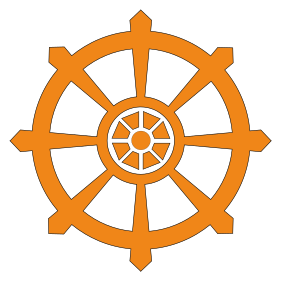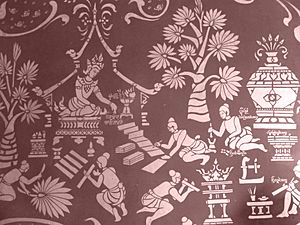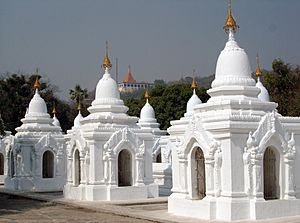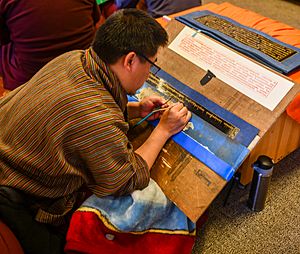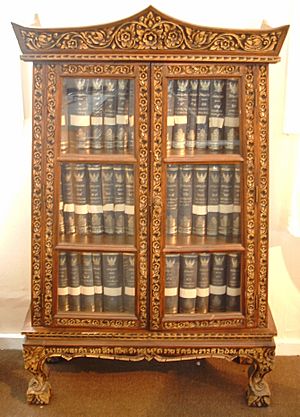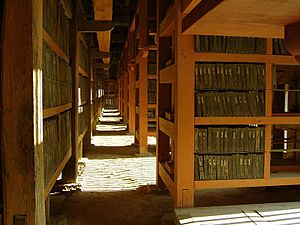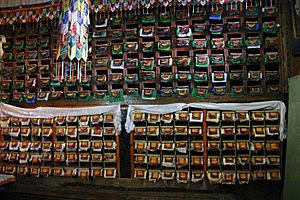Tripiṭaka facts for kids
Quick facts for kids Translations ofTipiṭaka |
|
|---|---|
| English | Three Baskets |
| Pali | Tipiṭaka |
| Bengali | ত্রিপিটক |
| Burmese | ပိဋကတ် သုံးပုံ |
| Chinese | 三藏 (Pinyin: Sānzàng) |
| Indonesian | Tiga Keranjang |
| Japanese | 三蔵 (さんぞう) (Rōmaji: sanzō) |
| Khmer | ព្រះត្រៃបិដក (UNGEGN: preăh traibĕdâk) |
| Korean | 삼장 (三臧) (RR: samjang) |
| Malay | Tiga Bakul |
| Sinhala | තිපිටකය (Tipitakaya) |
| Tagalog | Tatlo mga kahon |
| Thai | พระไตรปิฎก (RTGS: Phra Traipidok) |
| Vietnamese | Tam tạng (三藏) |
| Glossary of Buddhism | |
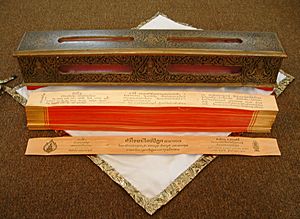

The Tipiṭaka or Tripiṭaka is a very old collection of Buddhist sacred writings. Its name means "Triple Basket." These texts contain the teachings of the Buddha and the rules for Buddhist monks and nuns.
Today, there are several important Tripiṭaka collections. These include the Pāli Canon used by the Theravāda tradition in Southeast Asia. There is also the Chinese Buddhist Canon for East Asian traditions. And the Tibetan Buddhist Canon is used by Tibetan traditions. Even though they are called "Tripiṭaka," some collections might have more or fewer than three main parts.
Contents
What Does Tripiṭaka Mean?
The word Tripiṭaka comes from Sanskrit (त्रिपिटक). In Pāli, it is Tipiṭaka. Both mean "Three Baskets."
- Tri or ti means "three."
- Piṭaka or piṭa means "basket."
These "three baskets" were originally like containers. They held the palm-leaf manuscripts where the Buddhist texts were kept. These texts were divided into three main groups: the Suttas, the Vinaya, and the Abhidhamma. These three divisions make up the main Buddhist scriptures.
The Three Main Baskets
The Tripiṭaka is made up of three main types of texts. These are the Sutra Piṭaka, the Vinaya Piṭaka, and the Abhidhamma Piṭaka.
Sutra Piṭaka: Teachings of the Buddha
The Sutra Piṭaka contains the main teachings and sermons of the Buddha. These teachings were first spoken by the Buddha in the Magadhan language. After the Buddha passed away, his followers gathered to remember and repeat his sermons. For a long time, these teachings were passed down orally. They were finally written down around the 1st century BCE.
Vinaya Piṭaka: Rules for Monks and Nuns
The Vinaya Piṭaka focuses on the rules and guidelines for monastic life. These rules cover everything from what monks and nuns should wear and eat to how they should behave. This part of the Tripiṭaka helped guide the Buddhist community as it grew from wandering teachers to settled monasteries.
Abhidhamma Piṭaka: Deeper Teachings
The Abhidhamma Piṭaka (or Abhidharma Piṭaka) contains deeper philosophical and psychological teachings. It explores the detailed analysis of Buddhist doctrines. It helps explain the mind and reality in a more advanced way.
Different Versions of the Tripiṭaka
Many early Buddhist schools likely had their own versions of the Tripiṭaka. Some sources even say there were schools with five or seven "baskets." An 8th-century Chinese traveler named Yijing noted that different schools in India had different sets of texts.
For example, the Sarvāstivāda school had a very complete collection of texts. Many of their Sutra Piṭaka and Vinaya Piṭaka texts still exist today in Chinese translations. The Dharmaguptaka school also had a version of the Tripiṭaka. Their texts are important because Buddhist monks in East Asia still follow the rules from the Dharmaguptaka Vinaya.
The Pāli Canon
The Pāli Canon is the complete Tripiṭaka used by the Theravāda tradition. It is written in the Pali language.
The exact age of the Tripiṭaka is not fully known. Scholars believe the Pāli Canon took its current form around the 3rd century BCE. It was passed down orally for centuries. Then, around the 1st century BCE, it was finally written down in Sri Lanka. This happened during a time of famine and war, so monks wanted to make sure the teachings were preserved. Over 1000 monks worked together to write down these texts at Aluvihare, Sri Lanka.
The Pāli Canon has the three main parts: Vinaya Pitaka (Basket of Discipline), Sutra Pitaka (Basket of Discourse), and Abhidhamma Piṭaka (Basket of Special Doctrine).
The Chinese Buddhist Canon
The Chinese Buddhist Canon is the Tripiṭaka collection used in East Asian Buddhist traditions. It is written and kept in Chinese.
Buddhist texts likely arrived in China from India around the 1st century BCE. An organized collection of these texts started to form around the 6th century CE. A very important catalog was created in 730 CE by Zhisheng. This catalog set the structure for the Chinese Canon. It helped rebuild the Canon after difficult times for Buddhism in China.
Famous Chinese Canons include the Taisho Tripitaka and the Tripitaka Koreana.
The Tibetan Buddhist Canon
The Tibetan Buddhist canon is a large collection of sacred texts used by different groups in Tibetan Buddhism. Besides the main Buddhist teachings, it also includes tantric texts. The final collection of the Tibetan Canon was put together in the 14th century by Buton Rinchen Drub.
The Tibetan Canon has two main parts:
- Kangyur: This part means "Translated Words." It contains texts believed to be the actual words spoken by the Buddha. Most of these texts were translated from Sanskrit.
- Tengyur: This part means "Translated Treatises." It includes commentaries, essays, and deeper philosophical works. The Tengyur has thousands of texts in many volumes.
Well-known Tibetan Canons include the Dege, Jiang, and Lhasa versions.
Sānzàng: A Special Title
In Chinese culture, the term "sānzàng" (三藏), which is the Chinese word for Tripiṭaka, was sometimes used as an honorary title. It was given to Buddhist monks who had mastered all the teachings of the Tripiṭaka.
A famous example is the Tang Dynasty monk Xuanzang. He traveled to India to study and bring Buddhist texts back to China. His journey was told in the popular novel Journey to the West. In the story, he is often called "Tang Sanzang" (meaning "Tripiṭaka Master of the Tang Dynasty"). Because of this novel, some people mistakenly think "sānzàng" is his actual name.
|
See also
- Early Buddhist Texts
- Buddhist texts
- Pāli Canon
- Tripiṭaka Koreana
- Xuanzang


